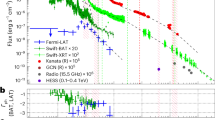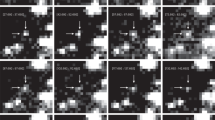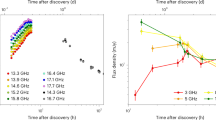Abstract
Relativistic jets around supermassive black holes are well-known powerful γ-ray emitters. In the absence of the jets in radio-quiet active galactic nuclei, how the supermassive black holes work in γ-ray bands is still unknown despite great observational efforts in the past three decades. Here, considering the previous efforts, we carefully select an active galactic nucleus sample composed of 37 nearby Seyfert galaxies with ultrahard X-rays for γ-ray detection by excluding all potential contamination in this band. Adopting a stacking technique, we report the significant γ-ray detection (test statistic 30.6, or 5.2σ) from the sample using 15-year Fermi-LAT observations. We find the average γ-ray luminosity of the sample to be (1.5 ± 1.0) × 1040 erg s−1 at energies of 1–300 GeV. Limited by the well-known pair production from the interaction of γ-rays with low-energy photons, γ-rays of more than several giga-electronvolts are found to originate from an extended corona (~2.7 × 106 gravitational radii), whereas the canonical much more compact X-ray corona (~10 gravitational radii) is responsible for γ-rays of one to several giga-electronvolts. The finding of the compact region lends strong support to the long-time theoretical expectations, but the extended corona is an unexpected finding. One promising scenario is that the electron–positron pairs produced in the compact X-ray corona would expand as a fireball, similar to that in γ-ray bursts, forming the structure of extended corona.
This is a preview of subscription content, access via your institution
Access options
Access Nature and 54 other Nature Portfolio journals
Get Nature+, our best-value online-access subscription
$32.99 / 30 days
cancel any time
Subscribe to this journal
Receive 12 digital issues and online access to articles
$119.00 per year
only $9.92 per issue
Buy this article
- Purchase on SpringerLink
- Instant access to full article PDF
Prices may be subject to local taxes which are calculated during checkout



Similar content being viewed by others
Data availability
The Fermi-LAT data are publicly available at https://fermi.gsfc.nasa.gov/ssc/data/access/.
References
Bisnovatyi-Kogan, G. S. & Blinnikov, S. I. Disk accretion onto a black hole at subcritical luminosity. Astron. Astrophys. 59, 111–125 (1977).
Galeev, A. A., Rosner, R. & Vaiana, G. S. Structured coronae of accretion disks. Astrophys. J. 229, 318–326 (1979).
Sunyaev, R. A. & Titarchuk, L. G. Comptonization of X-rays in plasma clouds—typical radiation spectra. Astron. Astrophys. 86, 121 (1980).
Bambic, C. J., Quataert, E. & Kunz, M. W. Local models of two-temperature accretion disc coronae—I. Structure, outflows, and energetics. Mon. Not. R. Astron. Soc. 527, 2895–2918 (2024).
Inoue, Y. & Doi, A. Detection of coronal magnetic activity in nearby active supermassive black holes. Astrophys. J. 869, 114 (2018).
Fabian, A. C. et al. Broad line emission from iron K- and L-shell transitions in the active galaxy 1H0707-495. Nature 459, 540–542 (2009).
Morgan, C. W. et al. Further evidence that quasar X-ray emitting regions are compact: X-ray and optical microlensing in the lensed quasar Q J0158-4325. Astrophys. J. 756, 52 (2012).
Reis, R. C. & Miller, J. M. On the size and location of the X-ray emitting coronae around black holes. Astrophys. J. Lett. 769, L7 (2013).
Haardt, F. & Maraschi, L. X-ray spectra from two-phase accretion disks. Astrophys. J. 413, 507 (1993).
Svensson, R. & Zdziarski, A. A. Black hole accretion disks with coronae. Astrophys. J. 436, 599 (1994).
Witt, H. J., Czerny, B. & Zycki, P. T. Accretion discs with accreting coronae in active galactic nuclei—II. The nuclear wind. Mon. Not. R. Astron. Soc. 286, 848–864 (1997).
Chael, A. A., Narayan, R. & Sadowski, A. Evolving non-thermal electrons in simulations of black hole accretion. Mon. Not. R. Astron. Soc. 470, 2367–2386 (2017).
Antonucci, R. & Barvainis, R. Excess 2 Centimeter Emission: a new continuum component in the spectra of radio-quiet quasars. Astrophys. J. Lett. 332, L13 (1988).
Wojaczyński, R., Niedźwiecki, A., Xie, F.-G. & Szanecki, M. Gamma-ray activity of Seyfert galaxies and constraints on hot accretion flows. Astron. Astrophys. 584, A20 (2015).
Inoue, Y., Khangulyan, D., Inoue, S. & Doi, A. On high-energy particles in accretion disk coronae of supermassive black holes: implications for MeV gamma-rays and high-energy neutrinos from AGN cores. Astrophys. J. 880, 40 (2019).
Inoue, Y., Khangulyan, D. & Doi, A. Gamma-ray and neutrino signals from accretion disk coronae of active galactic nuclei. Galaxies 9, 36 (2021).
Gutiérrez, E. M., Vieyro, F. L. & Romero, G. E. Nonthermal processes in hot accretion flows onto supermassive black holes: an inhomogeneous model. Astron. Astrophys. 649, A87 (2021).
Blandford, R. & Eichler, D. Particle acceleration at astrophysical shocks: a theory of cosmic ray origin. Phys. Rep. 154, 1–75 (1987).
Sironi, L. & Spitkovsky, A. Relativistic reconnection: an efficient source of non-thermal particles. Astrophys. J. Lett. 783, L21 (2014).
Romero, G. E., Vieyro, F. L. & Vila, G. S. Non-thermal processes around accreting galactic black holes. Astron. Astrophys. 519, A109 (2010).
Lin, Y. C. et al. EGRET limits on high-energy gamma-ray emission from X-ray- and low-energy gamma-ray-selected Seyfert galaxies. Astrophys. J. Lett. 416, L53 (1993).
Cillis, A. N., Hartman, R. C. & Bertsch, D. L. Stacking searches for gamma-ray emission above 100 MeV from radio and Seyfert galaxies. Astrophys. J. 601, 142–150 (2004).
Teng, S. H., Mushotzky, R. F., Sambruna, R. M., Davis, D. S. & Reynolds, C. S. Fermi/LAT observations of Swift/BAT Seyfert galaxies: on the contribution of radio-quiet active galactic nuclei to the extragalactic γ-ray background. Astrophys. J. 742, 66 (2011).
Ackermann, M. et al. Search for gamma-ray emission from X-ray-selected Seyfert galaxies with Fermi-LAT. Astrophys. J. 747, 104 (2012).
Koss, M. J. et al. BASS. XXII. The BASS DR2 AGN catalog and data. Astrophys. J. Suppl. Ser. 261, 2 (2022).
Ackermann, M. et al. GeV observations of star-forming galaxies with the Fermi Large Area Telescope. Astrophys. J. 755, 164 (2012).
Ajello, M., Di Mauro, M., Paliya, V. S. & Garrappa, S. The γ-ray emission of star-forming galaxies. Astrophys. J. 894, 88 (2020).
Ajello, M. et al. Gamma rays from fast black-hole winds. Astrophys. J. 921, 144 (2021).
McDaniel, A., Ajello, M. & Karwin, C. Gamma-ray emission from galaxies hosting molecular outflows. Astrophys. J. 943, 168 (2023).
Martocchia, A. & Matt, G. Iron Kα line intensity from accretion discs around rotating black holes. Mon. Not. R. Astron. Soc. 282, L53–L57 (1996).
Miniutti, G. & Fabian, A. C. A light bending model for the X-ray temporal and spectral properties of accreting black holes. Mon. Not. R. Astron. Soc. 349, 1435–1448 (2004).
Petrucci, P. O. et al. Testing comptonizing coronae on a long BeppoSAX observation of the Seyfert 1 Galaxy NGC 5548. Astrophys. J. 540, 131–142 (2000).
Wilkins, D. R. & Gallo, L. C. The comptonization of accretion disc X-ray emission: consequences for X-ray reflection and the geometry of AGN coronae. Mon. Not. R. Astron. Soc. 448, 703–712 (2015).
Fabian, A. C. et al. Properties of AGN coronae in the NuSTAR era. Mon. Not. R. Astron. Soc. 451, 4375–4383 (2015).
Kamraj, N. et al. X-ray coronal properties of Swift/BAT-selected Seyfert 1 active galactic nuclei. Astrophys. J. 927, 42 (2022).
Kara, E. et al. UV-optical disk reverberation lags despite a faint X-ray corona in the active galactic nucleus Mrk 335. Astrophys. J. 947, 62 (2023).
Svensson, R. Physical processes in active galactic nuclei. In IAU Colloq. 89: Radiation Hydrodynamics in Stars and Compact Objects (eds Mihalas, D. & Winkler, K.-H. A.) vol. 255, 325 (Springer, 1986).
Wang, J.-M., Li, Y.-R., Wang, J.-C. & Zhang, S. Spins of the supermassive black hole in M87: new constraints from TeV observations. Astrophys. J. Lett. 676, L109 (2008).
Neumayer, N., Seth, A. & Böker, T. Nuclear star clusters. Astron. Astrophys. Rev. 28, 4 (2020).
Ma, X.-H. et al. Chapter 1 LHAASO instruments and detector technology. Chin. Phys. C 46, 030001 (2022).
Actis, M. et al. Design concepts for the Cherenkov Telescope Array CTA: an advanced facility for ground-based high-energy gamma-ray astronomy. Exp. Astron. 32, 193–316 (2011).
Massaro, E. et al. The 5th edition of the Roma-BZCAT. A short presentation. Astrophys. Space Sci. 357, 75 (2015).
D’Abrusco, R. et al. Two new catalogs of blazar candidates in the WISE infrared sky. Astrophys. J. Suppl. Ser. 242, 4 (2019).
Wright, E. L. et al. The Wide-field Infrared Survey Explorer (WISE): mission description and initial on-orbit performance. Astron. J. 140, 1868–1881 (2010).
Gordon, Y. A. et al. A quick look at the 3 GHz radio sky. I. Source statistics from the Very Large Array Sky Survey. Astrophys. J. Suppl. Ser. 255, 30 (2021).
Shimwell, T. W. et al. The LOFAR Two-metre Sky Survey. V. Second data release. Astron. Astrophys. 659, A1 (2022).
Helfand, D. J., White, R. L. & Becker, R. H. The Last of FIRST: the final catalog and source identifications. Astrophys. J. 801, 26 (2015).
Mauch, T. et al. SUMSS: a wide-field radio imaging survey of the southern sky—II. The source catalogue. Mon. Not. R. Astron. Soc. 342, 1117–1130 (2003).
Condon, J. J. et al. The NRAO VLA Sky Survey. Astron. J. 115, 1693–1716 (1998).
Rengelink, R. B. et al. The Westerbork Northern Sky Survey (WENSS), I. A 570 square degree Mini-Survey around the North Ecliptic Pole. Astron. Astrophys. Suppl. 124, 259–280 (1997).
Wright, A. & Otrupcek, R. Parkes Catalog, 1990 (Australia Telescope National Facility, 1990).
Elvis, M. et al. Atlas of quasar energy distributions. Astrophys. J. Suppl. Ser. 95, 1 (1994).
Sikora, M., Stawarz, Ł. & Lasota, J.-P. Radio loudness of active galactic nuclei: observational facts and theoretical implications. Astrophys. J. 658, 815–828 (2007).
Ho, L. C. & Peng, C. Y. Nuclear luminosities and radio loudness of Seyfert nuclei. Astrophys. J. 555, 650–662 (2001).
Lacy, M. et al. The Karl G. Jansky Very Large Array Sky Survey (VLASS). Science case and survey design. Publ. Astron. Soc. Pac. 132, 035001 (2020).
Terashima, Y. & Wilson, A. S. Chandra snapshot observations of low-luminosity active galactic nuclei with a compact radio source. Astrophys. J. 583, 145–158 (2003).
Panessa, F. et al. The X-ray and radio connection in low-luminosity active nuclei. Astron. Astrophys. 467, 519–527 (2007).
Miller, L., Peacock, J. A. & Mead, A. R. G. The bimodal radio luminosity function of quasars. Mon. Not. R. Astron. Soc. 244, 207–213 (1990).
Visnovsky, K. L. et al. Radio properties of optically selected quasars. Astrophys. J. 391, 560 (1992).
Kellermann, K. I., Sramek, R. A., Schmidt, M., Green, R. F. & Shaffer, D. B. The radio structure of radio loud and quiet quasars in the Palomar Bright Quasar Survey. Astron. J. 108, 1163 (1994).
Véron-Cetty, M. P. & Véron, P. A catalogue of quasars and active nuclei: 13th edition. Astron. Astrophys. 518, A10 (2010).
Murase, K., Karwin, C. M., Kimura, S. S., Ajello, M. & Buson, S. Sub-GeV gamma rays from nearby Seyfert galaxies and implications for coronal neutrino emission. Astrophys. J. Lett. 961, L34 (2024).
Wang, M. et al. Dense gas in nearby galaxies. XVI. The nuclear starburst environment in NGC 4945. Astron. Astrophys. 422, 883–905 (2004).
Lenain, J. P., Ricci, C., Türler, M., Dorner, D. & Walter, R. Seyfert 2 galaxies in the GeV band: jets and starburst. Astron. Astrophys. 524, A72 (2010).
Ballet, J., Bruel, P., Burnett, T. H., Lott, B. & The Fermi-LAT Collaboration. Fermi Large Area Telescope Fourth Source Catalog Data Release 4 (4FGL-DR4). Preprint at https://arxiv.org/abs/2307.12546 (2023).
Tsuji, N. et al. Cross-match between the latest Swift-BAT and Fermi-LAT catalogs. Astrophys. J. 916, 28 (2021).
Oh, K. et al. The 105-Month Swift-BAT All-sky Hard X-Ray Survey. Astrophys. J. Suppl. Ser. 235, 4 (2018).
Baldwin, J. A., Phillips, M. M. & Terlevich, R. Classification parameters for the emission-line spectra of extragalactic objects. Publ. Astron. Soc. Pac. 93, 5–19 (1981).
Oh, K. et al. BASS. XXIV. The BASS DR2 spectroscopic line measurements and AGN demographics. Astrophys. J. Suppl. Ser. 261, 4 (2022).
Atwood, W. B. et al. The Large Area Telescope on the Fermi Gamma-Ray Space Telescope Mission. Astrophys. J. 697, 1071–1102 (2009).
Mattox, J. R. et al. The likelihood analysis of EGRET data. Astrophys. J. 461, 396 (1996).
Wilks, S. S. The large-sample distribution of the likelihood ratio for testing composite hypotheses. Ann. Math. Stat. 9, 60–62 (1938).
Reimer, O., Pohl, M., Sreekumar, P. & Mattox, J. R. EGRET upper limits on the high-energy gamma-ray emission of galaxy clusters. Astrophys. J. 588, 155–164 (2003).
Reiss, I. & Keshet, U. Detection of virial shocks in stacked Fermi-LAT galaxy clusters. J. Cosmol. Astropart. Phys. 2018, 010 (2018).
Huber, B., Farnier, C., Manalaysay, A., Straumann, U. & Walter, R. A stacking method to study the gamma-ray emission of source samples based on the co-adding of Fermi-LAT count maps. Astron. Astrophys. 547, A102 (2012).
Ackermann, M. et al. Constraining dark matter models from a combined analysis of Milky Way satellites with the Fermi Large Area Telescope. Phys. Rev. Lett. 107, 241302 (2011).
Paliya, V. S., Domínguez, A., Ajello, M., Franckowiak, A. & Hartmann, D. Fermi-LAT stacking analysis technique: an application to extreme blazars and prospects for their CTA detection. Astrophys. J. Lett. 882, L3 (2019).
Wood, M. et al. Fermipy: an open-source Python package for analysis of Fermi-LAT Data. In 35th International Cosmic Ray Conference (ICRC2017) vol. 301, 824 (eds Y.-S. Kwak, et al.) (SISSA Medialab, 2017).
James, F. & Roos, M. Minuit—a system for function minimization and analysis of the parameter errors and correlations. Comput. Phys. Commun. 10, 343–367 (1975).
Zdziarski, A. A., Johnson, W. N. & Magdziarz, P. Broad-band γ-ray and X-ray spectra of NGC 4151 and their implications for physical processes and geometry. Mon. Not. R. Astron. Soc. 283, 193–206 (1996).
Wang, J.-M., Watarai, K.-Y. & Mineshige, S. The hot disk corona and magnetic turbulence in radio-quiet active galactic nuclei: observational constraints. Astrophys. J. Lett. 607, L107–L110 (2004).
Blumenthal, G. R. & Gould, R. J. Bremsstrahlung, synchrotron radiation, and Compton scattering of high-energy electrons traversing dilute gases. Rev. Mod. Phys. 42, 237–271 (1970).
Inoue, S. & Takahara, F. Electron acceleration and gamma-ray emission from blazars. Astrophys. J. 463, 555 (1996).
Aharonian, F. A. Very High Energy Cosmic γ Radiation: A Crucial Window on the Extreme Universe (World Scientific Publishing, 2004).
Evans, P. A. et al. 2SXPS: an improved and expanded Swift X-ray telescope point-source catalog. Astrophys. J. Suppl. Ser. 247, 54 (2020).
Dermer, C. D. & Menon, G. High Energy Radiation from Black Holes: Gamma Rays, Cosmic Rays, and Neutrinos (Princeton Univ. Press, 2009).
Guo, F., Li, H., Daughton, W. & Liu, Y.-H. Formation of hard power laws in the energetic particle spectra resulting from relativistic magnetic reconnection. Phys. Rev. Lett. 113, 155005 (2014).
Ricci, C. et al. A tight correlation between millimeter and X-ray emission in accreting massive black holes from <100 mas resolution ALMA observations. Astrophys. J. Lett. 952, L28 (2023).
Laor, A. & Behar, E. On the origin of radio emission in radio-quiet quasars. Mon. Not. R. Astron. Soc. 390, 847–862 (2008).
Smith, K. L. et al. BAT AGN spectroscopic survey—XV: the high frequency radio cores of ultra-hard X-ray selected AGN. Mon. Not. R. Astron. Soc. 492, 4216–4234 (2020).
Graham, P. J. & Tingay, S. J. The importance of jet bending in gamma-ray AGNs—revisited. Astrophys. J. 784, 159 (2014).
Rojas, A. F. et al. BAT AGN Spectroscopic Survey—XIX. Type 1 versus type 2 AGN dichotomy from the point of view of ionized outflows. Mon. Not. R. Astron. Soc. 491, 5867–5880 (2020).
Freeman, K. C. et al. A large new galaxy in Circinus. Astron. Astrophys. 55, 445–458 (1977).
Guo, X.-L., Xin, Y.-L., Liao, N.-H. & Fan, Y.-Z. The Circinus Galaxy revisited with 10 yr Fermi-LAT data. Astrophys. J. 885, 117 (2019).
Peretti, E. et al. Gamma-ray emission from the Seyfert galaxy NGC 4151 and multimessenger implications for ultra-fast outflows. Preprint at https://arxiv.org/abs/2303.03298 (2023).
Inoue, Y. & Khangulyan, D. Gamma-ray emission in the Seyfert galaxy NGC 4151: investigating the role of jet and coronal activities. Publ. Astron. Soc. Jpn 75, L33–L39 (2023).
Healey, S. E. et al. CRATES: an all-sky survey of flat-spectrum radio sources. Astrophys. J. Suppl. Ser. 171, 61–71 (2007).
Acknowledgements
Useful discussions are acknowledged with P. Du, Y.-R. Li, Y.-J. Chen and Y.-L. Wang from the IHEP AGN Group. We thank the support from NSFC (grant numbers 12333003, 12273038, 11991050 and 11991054), from the National Key R&D Program of China (grant numbers 2020YFC2201400 and 2021YFA1600404). The Fermi-LAT Collaboration acknowledges support for LAT development, operation and data analysis from NASA and DOE (United States), CEA/Irfu and IN2P3/CNRS (France), ASI and INFN (Italy), MEXT, KEK and JAXA (Japan), and the K.A. Wallenberg Foundation, the Swedish Research Council and the National Space Board (Sweden). Science analysis support in the operations phase from INAF (Italy) and CNES (France) is also gratefully acknowledged. This work was performed in part under DOE Contract DE-AC02-76SF00515.
Author information
Authors and Affiliations
Consortia
Contributions
J.-M.W. conceived the project of γ-rays from radio-quiet AGNs and suggested the current corona model. J.L. led the project and drafted the first version of the paper. J.-R.L. led reduction of the Fermi data and drafted the Methods. J.L. and J.-M.W. led the revision of the manuscript by considering suggestions and comments from all the authors. All the authors discussed the contents, revised the first version and formed the final version of the paper.
Corresponding author
Ethics declarations
Competing interests
The authors declare no competing interests.
Peer review
Peer review information
Nature Astronomy thanks Vera G. Sinitsyna and the other, anonymous, reviewer(s) for their contribution to the peer review of this work.
Additional information
Publisher’s note Springer Nature remains neutral with regard to jurisdictional claims in published maps and institutional affiliations.
Supplementary information
Supplementary Information
Supplementary Figs. 1–11 and Tables 1–5.
Rights and permissions
Springer Nature or its licensor (e.g. a society or other partner) holds exclusive rights to this article under a publishing agreement with the author(s) or other rightsholder(s); author self-archiving of the accepted manuscript version of this article is solely governed by the terms of such publishing agreement and applicable law.
About this article
Cite this article
Liu, JR., Wang, JM. & Fermi-LAT Collaboration. Fermi detection of gamma-ray emission from the hot coronae of radio-quiet active galactic nuclei. Nat Astron 9, 1086–1097 (2025). https://doi.org/10.1038/s41550-025-02538-2
Received:
Accepted:
Published:
Issue date:
DOI: https://doi.org/10.1038/s41550-025-02538-2



